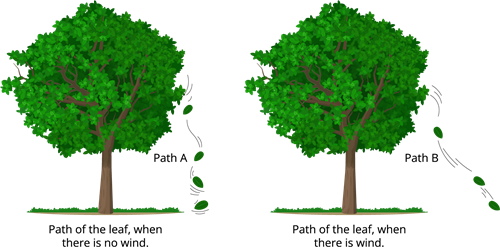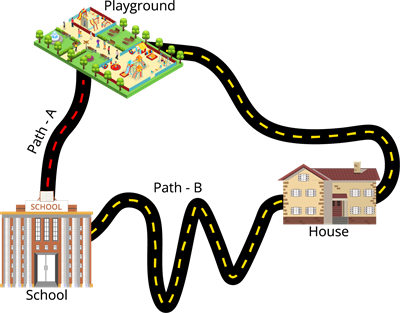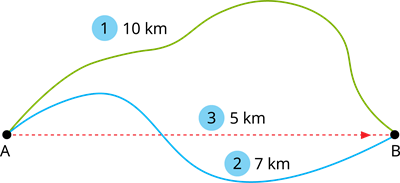
PUMPA - SMART LEARNING
எங்கள் ஆசிரியர்களுடன் 1-ஆன்-1 ஆலோசனை நேரத்தைப் பெறுங்கள். டாப்பர் ஆவதற்கு நாங்கள் பயிற்சி அளிப்போம்
Book Free DemoWe will learn about distance and displacement using real-life examples.
Look at the image carefully.
In which path the leaf will reach the ground first?
Path A or path B?

We will discuss one more example. Consider Arun and Rajesh are classmates at the same high school. They go to the nearby playground after school, play games, and then return home. Arun once stated that he would visit his grandmother's house before going to the playground. The route he took to get to the playground is depicted here.

Take a measuring tape and measure the length of the two paths (A & B). Which is the longest path among the two?
From the preceding examples, we can deduce that an object would reach its destination faster, if it follows a straight-line path. The shortest distance between two points is a straight-line path. Therefore, path B is the longest path.
Distance:
The total length of a path taken by an object to reach one place from the other is called distance.
Displacement:
The shortest distance from the initial to the final position of an object is called displacement.
The unit for both distance and displacement is the same. The SI unit is \(meter\) (\(m\)).
Example:
The below figure shows the different paths of a person who travels from point A to point B. Find the displacement.

Solution:
In the first path, he travels \(10\) \(kilometres\) to reach point B from point A. Then, he travels \(7\) \(kilometres\) on the second path to reach point B from point A. The shortest distance between the two points is \(5\) \(kilometres\)
As a result, the displacement is \(5\) kilometres (Towards the east).